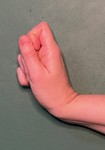Niṣedha
Saṃyuta Hasta - Double Hand Gestures
Descriptions and Meanings
9:139-140
If the Mukula hand is enturned with Kapittha hand it is Niṣadha hand, or The left hand holds the other arm above the elbow and the right hand touched fist. This also makes a Niṣadha hand.
9:141:
Patience, intoxication, arrogance, magnanimity, eagerness, valour, conceit, haughtiness, absence of motion, steadiness etc. are indicated by this hand.
9:139
Niṣadha—When the Kapittha hand surrounds the Mukulā hand the Niṣadha hand is made.
9:140:
It is used to indicate collecting, acceptance, holding, a doctrine, and to indicate brief truth the two hands are to press (each other).
9:140
Ka-Kha: Niṣadha—The left hand holding the [right] arm above the elbow and the right hand similarly touching the left arm with a clenched fist will make a Niṣadha hand.
(NOTE: NS by Ghosh gives two different Nisadha hands)
9:140:
It is to indicate patience, intoxication pride, elegance, eagerness, valour, arrogance self-conceit, haughtiness, motionlessness, steadiness and the like.
Not included elsewhere
26:61
When the Mukula hand covers the Kapittha hand, the combination should be known as Niṣadha.
26:62:
It should be made in shortening, throwing and compressing.
No verse annotation
Niṣedha (defense): the Mukula hand enclosed by the Kapittha hand. Patron deity Tumburu.
No verse annotation:
establishing the conclusion of an argument, truth, saying “Verily”, holding the nipples, anga-puja.

Kapittha - No verse annotation

Kapittha - No verse annotation

Mukula - No verse annotation

Mukula - No verse annotation
Not included elsewhere
8:522
If Mukula hasta is enclosed by Kapittha hasta, then it is Nishēdha hasta. Its presiding deity is Tumburu.
8:522:
This hasta is used to denote - establishing the conclusion of an argument, truth, saying ' yes/verily', holding the nipples and worshipping Sivalinga.

Kapittha - 7:306-308

Kapittha - 7:309-313

Mukula - 7:424-425

Mukula - 7:426-429
Not included elsewhere
4:1223-1225
Niṣadha: One hand in Kapittha Hasta encircles the other hand which is in Mukula Hasta.
4:1223-1225:
This Hasta is used to depict collecting, discriminating, speaking the truth and squeezing,
7:76
Naiṣada: If the right hand in the form of musti hasta is kept on the middle of the left elbow and the upper part of the hand on the right, it is nisada.
7:76:
It is used to show bravery or pride.
2:180-181
The left hand holds the right elbow and musti hasta of the right hand is tucked into the left elbow. This is niṣadha.
2:181:
This is used to hug the pillar, in fear, inquisitiveness, superior goodness or beauty, flatulence, steadiness, arrogance and intoxication.
:69
If the two elbows are clamped by the two alternate hands, it is called Nisadha hasta by the poets.
:771:
Firmness, pride, rapture, propriety, exception, ego, soberising, heroism, boast,
:772:
cringing of the body, eagerness, restraint, prowess, Parasurama—in these is Nisadha indicated. Detailed Description of the Subjects of Nisadha Hasta
:773:
In the subjects from ‘firmness’ to ‘prowess’ Nisadha can be applied to bring out various sentiments and various actions.
Not included elsewhere
:774
if after demonstrating Nisadha, there are strokes on the left arm,
:774:
Subhahkara holds it to represent Parasurama.
Not included elsewhere
7:107
When mukula (in one hand) is surrounded with kapittha (in the other), it is said to be niṣadha.
Not included elsewhere
3:455-456
When a mukula hand is encircled by kapittha it is known as nisadha.
3:455-456:
It is used to indicate correct understanding of the meaning of the scriptures, grinding, [to indicate] an established [fact] and saying 'This is true.' Some say that the first type of nisadha is gajadanta. This is used in valour, courage, majesty, pride etc.





